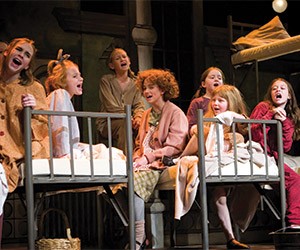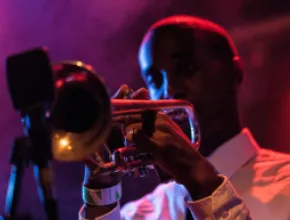It’s no accident that many icons of stage and screen—Henry Fonda, Marlon Brando and Johnny Carson, to name a few—had their roots in the Cornhusker State. Nebraska is home to renowned and long-established theater companies and other arts organizations, places that both nurture local talent and provide inspiring choices for entertainment and events.
Omaha
Omaha boasts one of the most vibrant fine-arts and performing-arts scenes in the nation, resulting in entertainment options and venues that greatly enhance its appeal for meetings, according to Janelle Armstrong, convention services manager for the Omaha CVB.
“We are blessed with a very creative population that has been drawn to the city,” she said. “We promote our arts scene to meeting planners—it’s something that can be part of meetings in a wide variety of ways.”
For a hands-on experience and personal look at the local arts scene, Armstrong recommends the Hot Shops Art Center, a complex of over 60 art studios devoted to glassblowing, printmaking, sculpture and other endeavors. The downtown arts center is a venue for catered events and also offers numerous participatory opportunities for visitors.
“You can walk in and watch everything from 3-D printmaking to large sculptural works in progress,” Armstrong said. “Groups can try their hand at glassblowing and make their own art. After the object is created, we can ship it home to them.”
Another way to delve into the local art scene is at the Bemis Center for Contemporary Arts, which provides work and livingspace for artists as well as opportunities for groups to participate in arts projects that benefit the community.
“We arranged for a group to go to the Bemis Center and participate in the painting of a large mural called Fertile Ground,” Armstrong said. “It’s now on the side of a building in downtown Omaha.”
Omaha is also known for its lively and eclectic theater scene. The Omaha Community Playhouse (OCP), the largest community theater in the U.S., presents a year-round season of plays in two venues, a 558-seat mainstage theater and a 230-seat black box theater devoted to experimental works. With a storied history that goes back to the 1920s, the OCP was where 20-year-old Henry Fonda made his stage debut in a play directed by Dodie Brando, mother of Marlon.
Both the OCP theaters are available for rent and planners can also arrange for groups to attend a performance in combination with a reception or other event. Along with the theaters, two lobbies, a rehearsal hall and an outdoor plaza are available.
Another acclaimed community theater, the Blue Barn Theatre, focuses on contemporary American plays and has supporters that include film director Alexander Payne, who has set films such as About Schmidt and Nebraska in his native state. The Rose Theater presents family-oriented productions in a restored Moorish-style movie palace that accommodates events for up to 900 guests.
Omaha Performing Arts operates two major venues. The Holland Performing Arts Center, home to the Omaha Symphony, offers a 2,000-seat concert hall, while the Orpheum Theater, a restored movie palace that shows Broadway touring productions, has a 2,000-seat theater and expansive lobby area available for receptions.
Named for Omaha jazz great Preston Love, Love’s Jazz & Arts Center focuses on African-American arts heritage, especially jazz and blues music, offering performances, lectures and art exhibits. Groups can rent the 10,000-square-foot venue, which includes a performance area and gallery, for special events.
South of Omaha, Nebraska City features unique attractions such as the Kregel Museum, which focuses on the manufacture of windmills, as well as the Arbor Lodge State Historical Park, original home of J. Sterling Morton, who founded Arbor Day. It is also home to the Lied Lodge & Conference Center, which offers art workshops such as the Canvas Painting Session, held at the Apple House Market, one of the retail shops at Arbor Day Farm.
Lincoln
Nebraska’s vibrant state capitol boasts a wide array of group-friendly museums and performing-arts venues that appeal to just about any interest, according to Derek Feyerherm, director of sales for the Lincoln CVB.
“We have a museum for everybody, whether it’s American Speed, the International Quilt Study Center, the Larsen Tractor Museum or the Telephone Museum,” he said. “We can work with the planner to find something new and creative for them.”
One of the most spectacular venues on the Lincoln arts scene is the Sheldon Museum of Art on the University of Nebraska campus, which includes works by Georgia O’Keeffe, Jackson Pollock, Andy Warhol, Edward Hopper and Mary Cassatt among its extensive collections. Designed by Philip Johnson, the Mid-Century museum features an imposing Grand Hall, a two-story area accommodating up to 300 guests. The museum’s Sculpture Garden hosts outdoor events amid works by Claes Oldenburg, Richard Serra and William Zorach.
PageBreak
In downtown Lincoln, Kiechel Fine Art is a two-story gallery located in a restored 120-year-old building with a roof deck. Offering changing exhibitions, the gallery can host up to 200 guests for meal functions and receptions.
Along with a season of headline performances in dance, music and theater, the Lied Center for Performing Arts offers several settings for events ranging from tradeshows to seminars and presentations requiring sophisticated audiovisual support. These include the 2,192-seat Mainstage Auditorium, 250-seat Johnny Carson Theater and an expansive lobby accommodating receptions for up to 400 guests.
With facilities that include a large dance floor and two full-service bars, the Bourbon Theatre is a restored 1920s movie theater that is now a popular concert venue in downtown Lincoln. The flexible space accommodates private movie screenings, presentations, concerts, receptions and other events.
Grand Island
Grand Island is home to the Sturh Museum of the Prairie Pioneer, one of the nation’s most important outdoor living-history attractions. The 200-acre complex is composed of important structures from around Nebraska, including Henry Fonda’s boyhood home, a Pawnee earth lodge, Victorian mansions and galleries filled with Plains Indian and pioneer artifacts and memorabilia. An area called Railroad Town depicts life in an 1894 Nebraska community, complete with printing press, jailhouse, stables, bank, stores and residences.
The centerpiece of the museum is the impressive Sturh Building, a mid-20th century landmark designed by Edward Durell Stone, whose other works include the John F. Kennedy Center for the Performing Arts in Washington, D.C. The Sturh Building recently reopened after an extensive renovation with art and history galleries as well as event space.
“We raised over $7 million to update the Stuhr Building, which is a great place for receptions,” said Michael Bockoven, director of marketing. “It also has a small auditorium that seats 120 people.”
The entire Stuhr complex can host groups of up to 2,000 or more, he added. Among the many options are taking over Railroad Town for parties and teambuilding events and holding dinners in the historic homes.
In downtown Grand Island, the Grand Theatre, an Art Deco movie palace adorned with glass tiles and a neon marquee, recently reopened after an extensive renovation. The historic theater, which still shows films and hosts the Prairie Lights Film Festival, is available for special events.
Kearney
The gem of Kearney’s fine-arts scene is the Museum of Nebraska Art (MONA), a stately Renaissance Revival structure primarily devoted to the works of Nebraska artists from the 19th century to the present day. Among its highlights are paintings depicting Nebraska’s early natural history by artists such as John James Audubon. The museum, which includes an outdoor sculpture garden, is available for receptions and other events.
The Kearney Community Theatre is the hub of the city’s theater scene, presenting five dramatic and musical productions each year. The theater, which has seating for up to 200 guests, is available for rent, along with its lobby, bar and green room.
Just outside Kearney, the elegant Minden Opera House is a restored 1891 theater that serves as a community performing arts center and event venue in downtown Minden. Its versatile main theater can be configured in a variety of set-ups for presentations and banquets accommodating up to 275 people. Smaller spaces include a boardroom, conference room and an upper lobby reception area.







